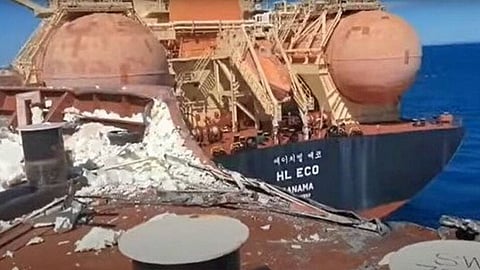COLUMN | "Bump and scrape" mishap off Australia: early warning signal of the risks of LNG fuel tanks [Grey Power]
It is a foolish mariner who will ignore storm signals when they are hoisted in plain sight. Just as it is somewhat late to regret putting to sea when it is obvious that the better strategy was to have stayed safely in port, there are some other early warnings that are possibly being ignored in the cause of achieving “net zero,” whatever that is.
One of these came with a somewhat bizarre accident on the Australian coast last July, when two Capesize bulkers collided in the anchorage off Hay Point in what would otherwise be described as a “low impact” event.
There was no blood spilt, not a great deal of structural damage on either vessel, after the out of control HL Eco scraped along the high flared bow of YM Serenity, from amidships to the afterdeck on the port side. One might imagine that the language would have been less than diplomatic on the two bridges.
With astonishing courage (although some might describe it as foolhardiness), one of the crew of YM Serenity produced an amazing blow-by-blow video (pictured) of the coming together, from his forecastle, as it took place before his eyes.
Such bumps happen occasionally, where big ships manoeuvre in close proximity, in confined spaces, or crowded anchorages. In this case, “issues” with the engine on HL Eco were cited. Doubtless the report into the event by the accident investigators will reveal all.
"If the LNG tank had been full, and pierced by the impact amid all that friction, one shudders to think of the consequences."
Being in Australia, where these things are done promptly and properly, (unlike in too many parts of the world where the people don’t bother), the findings of the Australian Maritime Safety Authority (AMSA) will be published in due course.
It would have been an incident that the wider world would have scarcely noticed, had it not been what one of these two vessels had positioned on her poop – an enormous insulated gas tank, part of the outfit that would have enabled this big bulker to have operated on the alternative fuel of LNG.
There were two of these huge cylindrical tanks on the poop of the ship and one of them was wrecked by the sweep of the bow of the other ship. Insulation was spread liberally around the wreckage and bow of YM Serenity, although the containment was said to have remained intact.
But by the grace of God and the fortune that just sometimes shines on us to mitigate impending disaster, the tank was empty, the ship still operating on fuel oil, which doubtless was in rather less vulnerable storage. If the tank had been full, and pierced by the impact amid all that friction, one shudders to think of the consequences, not least to the intrepid cameraman.
These giant deck fuel tanks are now seen as among the most spectacular solutions, as the industry threshes around in its efforts to show willing on the road to net zero. While LNG is now entrenched as the alternative (“bridging”) fuel of choice, there are now equally large deck tanks proposed for ammonia, which is both toxic and seriously flammable but is said to be more energy-rich than any other of the green fuels.
But the Hay Point “bump and scrape” surely ought to have rung some warning bells about the vulnerability of these containment systems, which are obviously far cheaper than integral underdeck storage solutions. Firstly, their proximity to the accommodation islands of these ships does not say much about the thought given by the designers, or by the approving authorities, to the safety of the crew. Would any of these clever people who design these things really like to live so close to such hazardous neighbours?
"Are we so transfixed and gung-ho on the 'net zero' solutions, that even bringing up such doubts is regarded as 'denialism'?"
Nothing new about ignoring the crew in the exciting business of ship design, but secondly, have there been any conversations with port authorities about the risk profile associated with such ships? And, perhaps more to the point, have the populations who live near to ports been alerted as to what is going on in the noble battle to mitigate climate change?
There are a lot of ports where there is a distinctly uneasy relationship between the needs of the commercial interests and those of the surrounding population, who will likely question the need for development and object to any noise, smell, air quality, and congestion problems that may arise. You can imagine that those who are hostile to the ports on their doorsteps will have a field day with such supposedly enhanced risks.
You would not want to wait for such an accident as happened off Hay Point, with, say, a deck tank of ammonia breached in a collision, with the resultant fires, plumes of toxic gas, and whatever other horrors might result. The various lobbies representing the alternative fuels will be quick to stifle such a hypothetical scenario, but has any of this been properly considered by the regulators and specifically at IMO?
Or are we so transfixed and gung-ho on the “net zero” solutions, that even bringing up such doubts is regarded as “denialism”? There is a warning signal flown from Hay Point, if anyone cares to see it.


